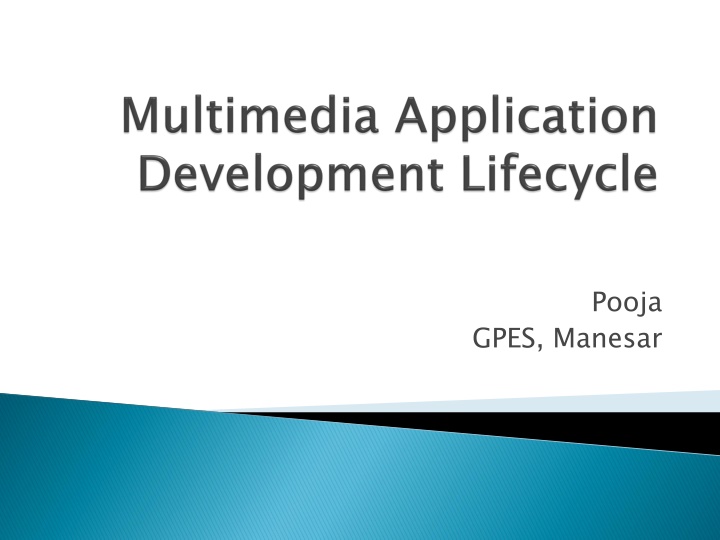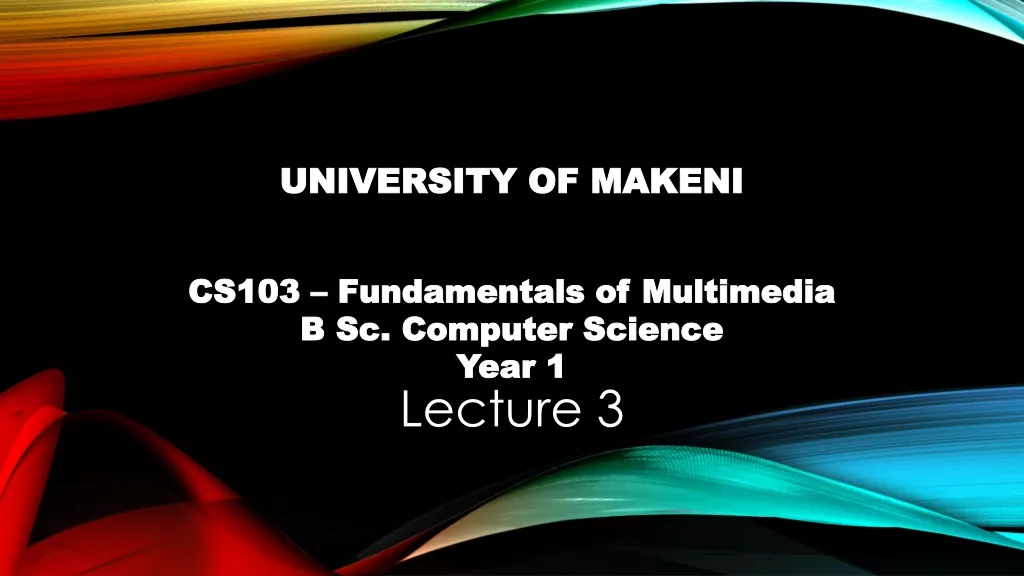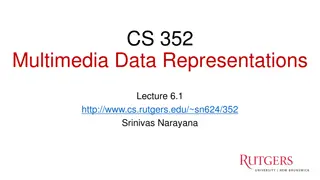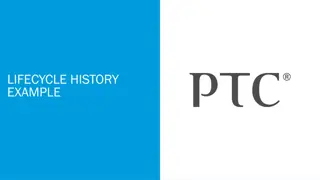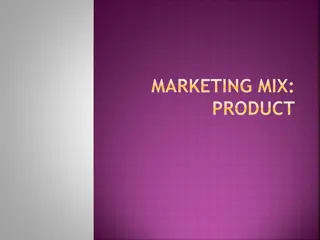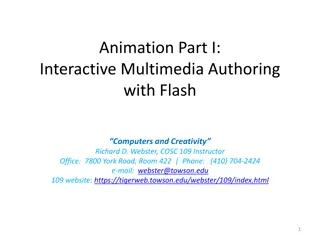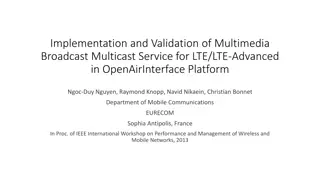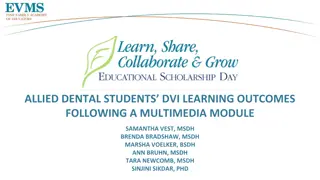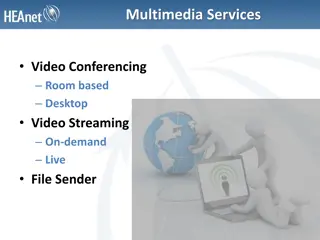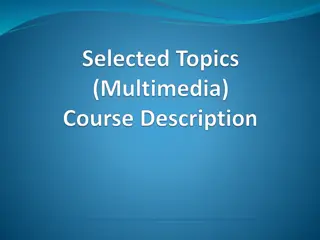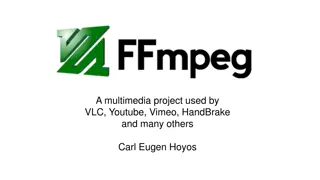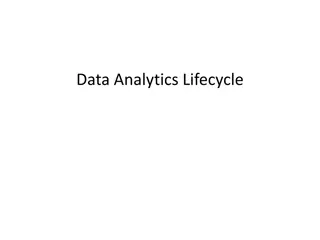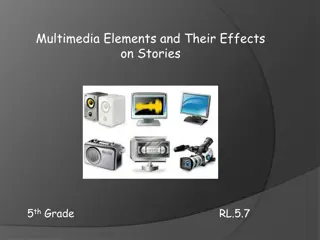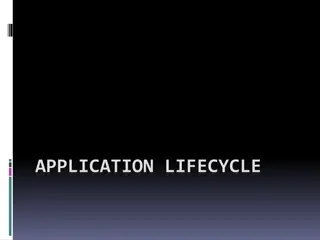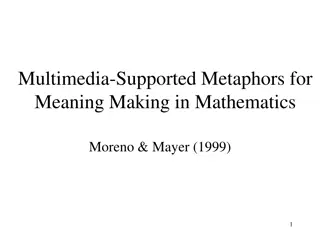Multimedia Application Development Lifecycle
The multimedia application development lifecycle shares similarities with software development lifecycles but includes both technical and creative aspects. Key phases include conceptualization, planning, design, prototyping, production, testing, distribution, and management. Phase 0 is crucial as it spans all other phases, involving activities like planning and resource management. A focus on defining objectives, analyzing finances, markets, and developing a business model is essential. Planning, estimating, monitoring, and controlling resources are vital for project success. Traditional project management tasks in multimedia projects involve orchestrating different technologies and resources in an ever-changing marketplace.
Download Presentation

Please find below an Image/Link to download the presentation.
The content on the website is provided AS IS for your information and personal use only. It may not be sold, licensed, or shared on other websites without obtaining consent from the author.If you encounter any issues during the download, it is possible that the publisher has removed the file from their server.
You are allowed to download the files provided on this website for personal or commercial use, subject to the condition that they are used lawfully. All files are the property of their respective owners.
The content on the website is provided AS IS for your information and personal use only. It may not be sold, licensed, or shared on other websites without obtaining consent from the author.
E N D
Presentation Transcript
Pooja GPES, Manesar
Multimedia application development lifecycle What is the same as in other product dev t lifecycles .. And what is different Individual phases and their characteristics
Most similarities can be found with the software development lifecycle computers involved the product itself is software requirements often vague and unstable Important differences: both technical and creative/artistic parts are present, with creative/artistic aspect often more important special equipment interface/conversion problems prototyping is a must
conceptualization and planning design and prototyping production testing distribution and follow-up and (of course) management
phase 0, because it spans all other phases, including activities such as planning estimation control resource management documenting
Defines objectives and means to achieve these objectives Analyze and define finances markets products distribution channels key employees Develop a business model
Planning, estimating, monitoring, controlling, and coordinating resources finances people material resources (equipment, tools, materials, ...) content in order to achieve the project objective Most important variables: time, cost, quality
Traditional project management tasks Additionally, the manager of a multimedia project must orchestrate different technologies persons (with skills and personalities) resources in a marketplace that is constantly evolving and changing
A common document which should help all interested parties to understand the defined goal understand the way of attaining the goal follow the schedule cooperate with others use the resources (tools and content) properly
$ Funding: the process of finding sources of capital to develop your product $ Various types of funding: $loans $grants $self-funding $venture capital But: each has good and bad sides
Many different specialties are required in each phase of the project Both technical and artistic specialties are needed They have different backgrounds (professional and cultural) skills and expertise and, of course, personalities
Different types of resources Computer hardware and software Production equipment Content (existing and new) How to obtain them? Borrow Lease Purchase Make your own
Securing sources of funding Licensing content and/or technology Hiring employees or contractors Drafting contracts Purchasing or leasing the necessary equipment, props, office space
Every multimedia project begins with an idea or concept The concept and the plan define a project Planning should make the realization of the concept as straightforward as possible
Projects often start with a meeting to discuss the project direction and plan Usually only a group of key players Serves to create and unite the team Defines and/or clarifies goals, roles, expectations, and strategies
the concept the purpose the message the approach What are you making? What is it for? What do you want to say? What will be used?
Electronic Books and Magazines Kiosks and Information Centers Multimedia Databases Corporate Training Interactive Education Interactive Games Interactive Music Interactive Movies Interactive Art and Performance Interactive Sales and Marketing Presentations and Communications
what is their background (with respect to age, education, gender, ) what are their preferences (even those prescribed by current fashion) are there some cultural and other constraints to be observed what equipment will they use to access your product (environment)
What is the message that you want to convey to your audience All components of your project must be related to its message Consistency Focusing Creativity Closely related to the approach
Identification: Is there a target audience at all? Is there significant competition? What could be our edge in the marketplace? Classification business vs. consumer early adopters vs. lazy ones
Is it technically feasible to create a product that is better, cheaper, more useful than anything else available Think about: Delivery media Installed base Storage capacity Speed Economy
Bridging the gap between the audience and you Design should embody concept, purpose, and messages Technology helps and often is indispensable but technology alone without the proper design creativity cannot do the trick
Simplicity Consistency User involvement Affordability Fun, efficiency, timing
Multimedia by definition includes user interaction and exploration Note: prettiest designs may not be the simplest, nor the easiest to use Good interaction design should instill a desire to go on and find out more However, efficiency is always an issue
Primarily related to user interface (we will have more to say about this) A good product should behave in a consistent manner Consistency reduces learning time and reduces chances for surprise, even with functions you have never used before Increased familiarity translates into increased productivity
Most people like to get involved Adding a human dimension to the communication with a mindless machine People enjoy exploring and discovering new paths reward curiosity by designing depth Allow users to explore more than one level of information but only if they explicitly choose to do so
Analyze what the users from the target group can afford Different audience segments have different amounts they are willing to spend on a given product Design goal: accommodate as much as possible within a given price range
some applications can be fun to use (but each user can have his or her own definition of what exactly is fun ) user comprehension has its own pace try to be neither too fast, nor too slow performance is always an issue: but this is predominantly a technical problem
Often begins with a brainstorming session a dynamic process of gathering ideas and exploring possibilities without judgement or constraint A good brainstorming session results in a collection of ideas and solutions that become the foundation for both the design and the prototype developed from it
An illustrated scene-by-scene plan for telling a story: represents actions, images and narration unfolding over time Each significant frame is described in (some) detail, the actors are outlined, and their important actions are spelled out Storyboard may be considered to be a specification of the prototype (and, ultimately, the product itself)
How to organize and present information in a clear, accurate, meaningful and useful form Includes the information in all media and their visual interaction (to an extent)
A limited implementation of a design Emphasizes exploration and experimentation Prototyping helps simplify and improve production process Often used as proof-of-concept and/or testing purposes Multimedia applications must be prototyped
A complete list of features that covers structure and behavior of the product should emerge from the prototyping phase In multimedia, this means type and amount of content, interface characteristics, and interaction
Organizing people and resources Providing and producing content text, graphics, videos, sound, animation, VR Integrating all of the above into a meaningful, coherent product Details of production related to different media types will be covered in a separate lecture
Specification of all the tasks and their interdependencies in sufficient detail Estimates should be made for each task (i.e., time and effort / manpower) Appropriate resources should be allocated A number of milestones has to be established Main project goals must be established Deliverables: the product itself, documentation and additional materials
Responsibilities and roles should be clearly delineated and defined Some people may take on different roles (well-defined tasks are a must) Professional services should be used whenever possible (at a cost) Remember: quality obtained is always proportional to investment made
Organizing resources: define what is required and a schedule of its usage Equipment selection: based on the project script and on the actual shooting location Major equipment has its own schedule, with each major piece assigned to a person Compatibility issues must be resolved
Source: any items containing media data that can be used in our product Production can involve creating new source materials, converting (re-purposing) existing materials, or (most often) both Source materials must be indexed and kept in order (do not delete anything, never)
Most important criteria: Whether the production artists are familiar with the tool(s) selected Whether the format used by the tool is compatible with other tools Availability and cost may be important for small projects: in large projects, the cost is never a big part of the overall budget
Integrating content elements: usually the responsibility of programmer(s) Project manager must overview integration Project manager should make sure that no content is forgotten or missing Problems of all types tend to multiply as the delivery time is approaching
Necessary in order to create a product with a sense of integrity and unity Use of punctuation, grammatical conventions, use of jargons Samples, illustrations and templates for graphical layout Graphics production: standards used, layout templates Video production Sound production Conducting and attending production meetings
Different types of documentation may be needed, depending on the project Both size and scope depend on the project and its intended audience Mass audience requires the documentation to be as simple as possible, together with additional materials (getting started, tutorials, ) Narrow, well-educated audience require in-depth coverage, description of more sophisticated functions Internet helps
Walking in user's shoes before the user does so Main questions When to test What to test How to test When to stop testing But the crucial question is: can testing give us complete confidence in the product?
Different types of testing: functional, content testing, collateral materials testing, user testing Different timing: alpha, beta, user testing Test plan with relevant information on schedule resources testing environment deliverables
Activities related to: Preparation and duplication of physical media Choosing distribution options and channels Marketing Sales
Publishers Affiliated label program Self-publishing Mail order catalogs Distributors Retailers Education and government markets Content-specific stores Direct mail Bundling
Public relations press releases, press kits, trade shows Promotions Advertising Meetings, presentations and negotiations Sales calls Product demonstrations
Development wrap-up Maintenance Training Documentation Customer relations Pursuing additional opportunities
To determine the actual schedule and costs and compare them against the original estimates To find out ways in which the process (and subsequent products) could be improved In other words: how we did it, and what have we learned by doing it (that coul dhelp us fare better next time)
Providing assistance to customers and clients in response to specific problems and inquiries Internet helps here as well Main activities: maintenance training Multimedia titles generally need little support
